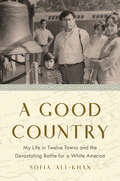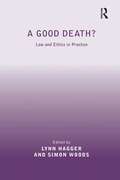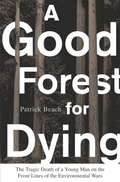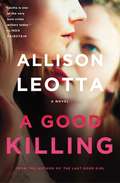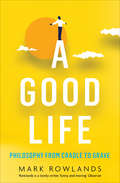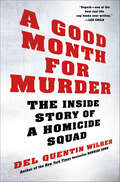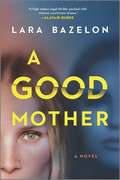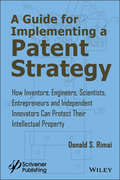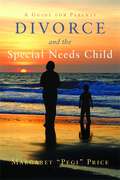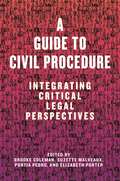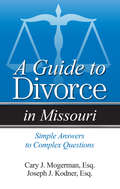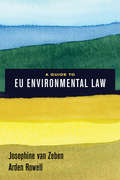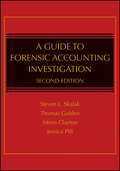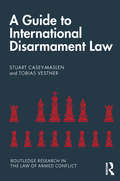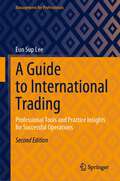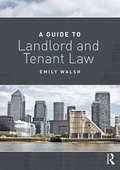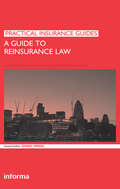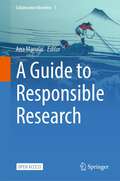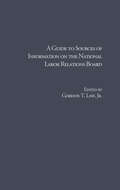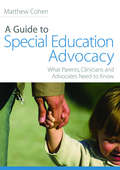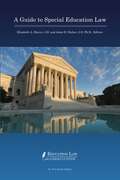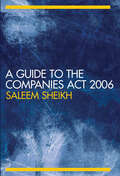- Table View
- List View
A Good Country: My Life in Twelve Towns and the Devastating Battle for a White America
by Sofia Ali-KhanA leading advocate for social justice excavates the history of forced migration in the twelve American towns she&’s called home, revealing how White supremacy has fundamentally shaped the nation. &“At a time when many would rather ban or bury the truth, Ali-Khan bravely faces it in this bracing and necessary book.&”—Ayad Akhtar, Pulitzer Prize–winning author of Homeland Elegies Sofia Ali-Khan&’s parents emigrated from Pakistan to America, believing it would be a good country. With a nerdy interest in American folk history and a devotion to the rule of law, Ali-Khan would pursue a career in social justice, serving some of America&’s most vulnerable communities. By the time she had children of her own—having lived, worked, and worshipped in twelve different towns across the nation—Ali-Khan felt deeply American, maybe even a little extra American for having seen so much of the country. But in the wake of 9/11, and on the cusp of the 2016 election, Ali-Khan&’s dream of a good life felt under constant threat. As the vitriolic attacks on Islam and Muslims intensified, she wondered if the American dream had ever applied to families like her own, and if she had gravely misunderstood her home. In A Good Country, Ali-Khan revisits the color lines in each of her twelve towns, unearthing the half-buried histories of forced migration that still shape every state, town, and reservation in America today. From the surprising origins of America&’s Chinatowns, the expulsion of Maroon and Seminole people during the conquest of Florida, to Virginia&’s stake in breeding humans for sale, Ali-Khan reveals how America&’s settler colonial origins have defined the law and landscape to maintain a White America. She braids this historical exploration with her own story, providing an intimate perspective on the modern racialization of American Muslims and why she chose to leave the United States. Equal parts memoir, history, and current events, A Good Country presents a vital portrait of our nation, its people, and the pathway to a better future.
A Good Death?: Law and Ethics in Practice
by Simon WoodsThis interdisciplinary collection presents valuable discourse and reflection on the nature of a good death. Bringing together a leading judge and other legal scholars, philosophers, social scientists, practitioners and parents who present varying accounts of a good death, the chapters draw from personal experience as well as policy, practice and academic analysis. Covering themes such as patients’ rights to determine their own good death, considering their best interests when communication becomes difficult and the role and responsibilities of health professionals, the book outlines how ethical healthcare might be achieved when dealing with assisted suicide by organizations and how end of life services in general might be improved. It will be of interest to students and academics working the area of medical law and ethics as well as health professionals and policy-makers.
A Good Forest for Dying: The Tragic Death of a Young Man on the Front Lines of the Environmental Wars
by Patrick BeachEarly on a September morning in 1998, David “Gypsy” Chain and eight fellow Earth First! activists went into the redwood forests of Scotia, California. Their loosely organized plan to protest the destruction caused by the logging industry almost immediately turned farcically tragic. A. E. Ammons, a logger for Pacific Lumber, confronted the group, threatening them in an obscenity-ridden diatribe: if they didn't leave "I'll make sure I got a tree comin' this way!" The group retreated, moving deeper into the wilderness. A short time later, just as they were attempting to confront the logger yet again, Gypsy was dead, crushed to death by a tree Ammons felled. A GOOD FOREST FOR DYING traces the long history of bitter clashes between environmental concerns and economic interests in the American West and shows why these tensions came to a head in northern California in the 1990s. It tells the story of how Pacific Lumber, once an environmentally friendly, family-owned business, became part of a conglomerate whose business practices made it a ripe target for environmental activists. But A GOOD FOREST FOR DYING is also the story of Gypsy Chain, a troubled young man raised in a loving family. A social misfit in his small Texas hometown, he died in a faraway forest before he had a chance to come to terms with himself and his family. His mother never lost faith in her sometimes wayward, idealistic son. After his death, and helped by a team of shrewd, leftist lawyers, she mounted a fight for justice in the name of her son and the cause of saving the redwoods. A balanced, highly readable examination of complex, emotionally charged issues, A GOOD FOREST FOR DYING will appeal to a wide audience. Its insights into the inner workings of the radical environmental movement and its dissection of corporate greed and misdeeds are reminiscent of such provocative exposés as A Civil Action and Erin Brockovich. The story of Gypsy’s strange odyssey and the disturbing circumstances of his death–seen primarily through the eyes of his mother–is as powerful and as moving as Jon Krakauer’s classic Into the Wild.
A Good Killing: A Novel (Anna Curtis Series #4)
by Allison LeottaFormer federal prosecutor and critically acclaimed author Allison Leotta’s spellbinding thriller follows prosecutor Anna Curtis as she heads home to Michigan to defend her sister in a case that will bring her to her knees.How far would you go to save your sister? Anna Curtis is back in her hometown just outside of Detroit. Newly single after calling off her wedding, Anna isn’t home to lick her wounds. She’s returned to support her sister, Jody, who has been wrongfully accused of murder after their old high school coach, a local hero, dies in a suspicious car crash. But maybe Jody isn’t so innocent after all. The police are convinced that Jody was having an affair with the married coach and killed him out of jealousy. As Anna investigates with the help of her childhood friend Cooper Bolden, an Afghan War veteran with a secret of his own, she slowly peels back the facade of her all-American town and discovers that no one is telling the truth about the coach, not even the people she thought she knew best. When the town rallies against them, threatening not just Jody’s liberty but both sisters’ lives, Anna resolves to do everything she can to save her sister and defend the only family she has left. In her best book yet, Leotta, “the female John Grisham” (The Providence Journal), explores the limits of vigilante justice, the bonds of sisterhood, and the price of the truth.
A Good Life: For You And Your Relative With A Disability
by Al EtmanskiA Good Life offers a very different perspective about what is truly important when contemplating the future of people with disabilities. A Good Life catapults over the traditional supports and services available to most people with disabilities and suggests another approach.
A Good Life: Philosophy from Cradle to Grave
by Mark RowlandsFramed by the story of a son finding his late father&’s journal, a meditation on love, meaning, and morality by the author of The Philosopher and the Wolf. Myshkin was born on a certain day and died on a certain day—and some things happened to him in between. These things presented him with ethical questions, and this book is a record of his attempt to answer those questions. Discovered in 2054 by his son after Myshkin's death in the Florida Keys, A Good Life is one man's reckoning with the life he has led and the choices he made. It is at once a philosophical handbook for living and a page-turning narrative, following one man's life (birth, death, education, religion, morality, illness, and so on) told through a philosophical lens. It is a riveting examination of the ethical questions we face, and the decisions we must make, and a defense of the idea that at the beating heart of morality we find love. Sometimes profoundly funny, sometimes deeply serious, A Good Life is as readable as a novel and as provocative as the best philosophy. It is the finest work to date by a charming and brilliant thinker. &“A lovely writer, funny and moving.&”—Observer
A Good Man with a Dog: A Retired Game Warden's 25 Years in the Maine Woods
by Kate Clark Flora Roger GuayA game warden’s journey from the woods of Maine to the swamps of New Orleans. When Roger Guay’s father died in a tragic fishing accident, a kind game warden helped him through the loss. Inspired by this experience, as well as his love of the outdoors, Guay became a game warden and certified K9 handler, beginning a successful career that would span twenty-five years and see him establish canine units as a staple of the game warden service. Guay takes readers into the patient, watchful world of a warden catching poachers and protecting pristine wilderness, and the sometimes CSI-like reconstruction of deer- and moose-poaching scenes. Guay searches for lost hunters and hikers, estimating that over the years, he has pulled more than two hundred bodies out of Maine’s north woods. His frequent companion is a little brown lab named Reba, who can find discarded weapons, ejected shells, hidden fish, and missing people.A Good Man with a Dog explores Guay’s life as he and his canine partners are exposed to increasingly terrible events, from tracking down hostile poachers to searching for victims of violent crimes, including a year-long search for the hidden graves of two babies buried by a Massachusetts cult. He witnessed firsthand FEMA’s mismanagement of the post-Katrina cleanup efforts in New Orleans, an experience that left him scarred and disheartened. But he found hope with the support of family and friends, and eventually returned to the woods he knew and loved from the days of his youth.
A Good Month for Murder: The Inside Story of a Homicide Squad
by Del Quentin WilberBestselling author Del Quentin Wilber tells the inside story of how a homicide squad---a dedicated, colorful team of detectives—does its almost impossible jobTwelve homicides, three police-involved shootings and the furious hunt for an especially brutal killer--February 2013 was a good month for murder in suburban Washington, D.C.After gaining unparalleled access to the homicide unit in Prince George's County, which borders the nation's capital, Del Quentin Wilber begins shadowing the talented, often quirky detectives who get the call when a body falls. After a quiet couple of months, all hell breaks loose: suddenly every detective in the squad is scrambling to solve one shooting and stabbing after another. Meanwhile, the entire unit is obsessed with a stone-cold "red ball," a high-profile case involving a seventeen-year-old honor student attacked by a gunman who kicked down the door to her house and shot her in her bed.Murder is the police investigator's ultimate crucible: to solve a killing, a detective must speak for the dead. More than any recent book, A Good Month for Murder shows what it takes to succeed when the stakes couldn't possibly be higher.
A Good Mother: A Novel
by Lara BazelonA Library Journal Best Debut Novel of Spring and Summer 2021"A high-stakes legal thriller packed with intense courtroom drama." -Alafair BurkeA gripping debut thriller about two young mothers, one shocking murder and a court case that puts them both on trial.When a soldier is found stabbed through the heart at a US Army base, there is no doubt that his wife, Luz, is to blame. But was it an act of self-defense? An attempt to save her infant daughter? Or the cold-blooded murder of an innocent man?Ambitious public defender Abby is determined to win at all costs. As a new mother herself, she wants to keep Luz out of prison and with her daughter. But when the surprises stack up and shocking new evidence emerges, Abby realizes the task proves far more difficult than she suspected and will require a terrible sacrifice.As the trial hurtles toward an outcome no one expects, Abby, Luz and a captivated jury are forced to answer the question that will decide everything—what does it mean to be a good mother?&“Lara Bazelon combines a riveting courtroom thriller with a nuanced and thought-provoking examination of gender, race, and justice. Helmed by an intelligent, complex, and flawed protagonist, A Good Mother is a beautifully written debut that kept me turning the pages late into the night.&” —Angie Kim, author of Miracle Creek"Sexy, shrewd, and wholly contemporary, A Good Mother takes pitch-perfect characters, a page-whipping plot, and themes about marriage, lust, betrayal, and the juggling of new motherhood plus a hard-driving career and mixes it all into a deeply perceptive legal thriller that made me drop everything else and just READ." —Cathi Hanauer, New York Times bestselling author of Gone, The Bitch in the House and The Bitch Is Back
A Guide for Implementing a Patent Strategy: How Inventors, Engineers, Scientists, Entrepreneurs, and Independent Innovators Can Protect Their Intellectual Property
by Donald S. RimaiThis book is aimed at the innovators who drive the advances from which we all benefit. This includes scientists, engineers, technicians, managers, and entrepreneurs who want to financially benefit from their innovations. The book describes how to build patent portfolios that will properly protect your technology and be of financial benefit. The tools that innovators need to have to generate patents are presented in detail.
A Guide for Parents Divorce and the Special Needs Child
by Margaret Pegi" PriceGoing through a divorce is always tough, but when a child with special needs is involved it can be especially challenging. This book takes a clear and comprehensive look at every aspect of the legal divorce process, and addresses all of the legal issues that divorcing parents of children with special needs face. The author guides parents through the initial hurdles of choosing the right lawyer for their case, and explains exactly how to work with them to achieve the best possible outcome for all concerned. From agreeing upon child custody arrangements that meet the particular needs of the child, to making provision for child support payments, gathering together the documentation needed to prove a case, and dealing with financial issues such as debts and property distribution, no aspect of divorce is left uncovered. A set of checklists is included to ensure that parents consider everything they need to, and the book concludes with a useful list of further resources. Written by an experienced family lawyer who went through her own divorce when her son, who has autism, was six, this book offers much-needed guidance to divorcing parents of children with a variety of special needs.
A Guide to Civil Procedure: Integrating Critical Legal Perspectives
by Brooke Coleman, et al.Shines a light on the ways in which civil procedure may privilege—or silence—voices in our justice systemIn today’s increasingly hostile political and cultural climate, law schools throughout the country are urgently seeking effective tools to address embedded inequality in the United States legal system. A Guide to Civil Procedure aims to serve as one such tool by centering questions of systemic injustice in the teaching, learning, and practice of civil procedure.Featuring an outstanding group of diverse scholars, the contributors illustrate how law school curriculums often ignore issues such as race, gender, disability, class, immigration status, and sexual orientation. Too often, students view the #MeToo movement, Black Lives Matter, immigration/citizenship controversy, or LGBTQ+ issues as mere footnotes to their legal education, often leading to the marginalization of many students and the production of graduates that do not view issues of systemic injustice as central to their profession.A Guide to Civil Procedure reveals how procedure is, and always has been, a central pressure point in the struggle to eradicate structural inequality and oppression through the courts. This book will give students and scholars alike a more complex view of their roles as attorneys, sharpen their litigation skills, and provide a stronger sense of community and purpose in the law school classroom.
A Guide to Divorce in Missouri: Simple Answers to Complex Questions (Divorce In)
by Cary J. Mogerman Joseph J KodnerProviding accurate and objective information to help make the right decisions during a divorce in Missouri, this guide provides answers to 360 queries such as What is the mediation process in Missouri and is it required? How quickly can one get a divorce? Who decides who gets the cars, the pets, and the house? What actions might influence child custody? How are bills divided and paid during the divorce? How much will a divorce cost? and Will a spouse have to pay some or all attorney fees? Structured in a question-and-answer format, this divorce handbook provides clear and concise responses to help build confidence and give the peace of mind needed to meet the challenges of a divorce proceeding.
A Guide to EU Environmental Law
by Arden Rowell Josephine van ZebenWritten by two internationally respected scholars, this unique primer distills European Union environmental law and policy into a practical guide for a nonlegal audience, as well as for lawyers trained in other jurisdictions. The first part explains the basics of the European legal system, including key actors, types of laws, and regulatory instruments. The second part describes the EU’s overarching legal strategies for environmental management and delves into how the EU addresses the specific environmental issues of pollution, ecosystem management, and climate change. Chapters include summaries of key concepts and discussion questions, as well as informative "spotlights" offering brief overviews of topics. With a highly accessible structure and useful illustrative features, A Guide to EU Environmental Law provides a long-overdue synthetic resource on EU environmental law for students and for anyone working in environmental policy or environmental science.
A Guide to Forensic Accounting Investigation
by Thomas W. Golden Steven L. Skalak Mona M. Clayton Jessica S. PillRecent catastrophic business failures have caused some to rethink the value of the audit, with many demanding that auditors take more responsibility for fraud detection. This book provides forensic accounting specialists?experts in uncovering fraud?with new coverage on the latest PCAOB Auditing Standards, the Foreign Corrupt Practices Act, options fraud, as well as fraud in China and its implications. Auditors are equipped with the necessary practical aids, case examples, and skills for identifying situations that call for extended fraud detection procedures.
A Guide to International Disarmament Law (Routledge Research in the Law of Armed Conflict)
by Stuart Casey-Maslen Tobias VestnerDisarmament is integral to the safeguarding and promotion of security, development, and human rights. Hundreds of millions of dollars are spent each year on disarmament operations, yet no comprehensive guide exists to explain clearly the international rules governing disarmament. This book seeks to fill that gap. It describes the international legal rules that govern disarmament and the operational, political, and technical considerations that govern their implementation. This book aims to support compliance, implementation, and further development of international disarmament law. Traditionally, disarmament focused on weapons of mass destruction. This remains a critically important area of work. In recent decades, the scope of disarmament has broadened to encompass also conventional weapons, including through the adoption of rules and regulations to govern arms transfers and measures to eliminate specific munitions from stockpiles and to destroy explosive remnants of war. There have also been four "generations" of programmes to address small arms and light weapons at national or sub-national level through disarmament, demobilisation, and reintegration (DDR) programmes during and following the end of armed conflict. While an internationally accepted definition of disarmament does not yet exist, it is widely agreed that disarmament encompasses or interrelates with prohibitions and restrictions on the development, production, stockpiling, testing, and transfer of weapons and on their destruction. In addition to clarifying these elements, chapters of this guide will also consider the relationship between disarmament and the law of armed conflict, and with the United Nations Security Council, human security, public health, and non-state actors.
A Guide to International Trading: Professional Tools and Practice Insights for Successful Operations (Management for Professionals)
by Eun Sup LeeThis book offers a practical guide for successful international trade operations. Written for MBA students and professionals, it provides tools and best practices for managing and operating complex international trade transactions. Readers learn about the legal, administrative, and practical aspects of international business transactions and how to gather and manage the proper information needed. The book covers topics such as public and private regulation of international trade, overseas market research, international trade terms, international trade contracts, payment collection, international transportation, marine cargo insurance, exchange rate risk, electronic commerce, and claims and dispute resolution. It is a valuable resource for both business students and professionals involved in international trade or export businesses.
A Guide to Landlord and Tenant Law
by Emily WalshA Guide to Landlord and Tenant Law provides a strong foundation in commercial landlord and tenant, and housing law. The book is designed to provide a complete course text for both undergraduate and postgraduate students from surveying and real estate management backgrounds. This clear and accessible textbook aims to introduce the reader to the fundamentals of both residential and commercial landlord and tenant law by considering the nature of the tenancy and the relationship between the parties. It examines the main elements of the commercial lease including rent, repair, alienation, termination and statutory renewal. The main types of residential tenancy are also considered including: assured and assured shorthold tenancies, secure and Rent Act tenancies and long leasehold enfranchisement. The book aims to familiarise the reader with the contractual documentation as well as the common law and statutory codes which form the basis of landlord and tenant transactions. It contains useful features such as: extracts from the Model Commercial Lease key case summaries, a glossary and chapter summaries further reading lists In addition, students on the Legal Practice Course and Bar Professional Training Course will find this to be a useful supplementary resource as will professional surveyors and lawyers looking for a refresher on the latest landlord and tenant law.
A Guide to Reinsurance Law (Practical Insurance Guides)
by Robert MerkinThis practical guide offers a useful introduction to reinsurance, taking you step by step through the associated issues you really need to know about. An introduction is provided, setting the scene for further chapters on key topics such as the formation of agreements, terms, rights and obligations. The book covers the following areas: Nature of Reinsurance, Formation of Reinsurance, Agreements, Utmost Good Faith, Terms of Reinsurance Agreements, Rights and Obligations of the Parties, Follow the Settlements and Follow the Fortunes, Claims, Intermediaries, Jurisdiction and Applicable Law, Arbitration.
A Guide to Responsible Research (Collaborative Bioethics #1)
by Ana MarušićThis Open Access book is a guide to good, responsible research at each step of the process of research discovery, so that a researcher at the beginning of a scientific career has a clear pathway to doing good research and producing reliable results.The textbook will give context to the practices described in the European Code of Conduct for Research Integrity, guided by the fundamental principles or research integrity – reliability, honesty, respect, and accountability. Although we base the book on the European Code, the principles are the same in the global research community, such as those outlined in Fostering Integrity in Research from the US National Academies; Engineering and Medicine. The chapters in the book follow good research practices, give practical advice and address basic principles. In this way, the book is applicable to different research fields. It directs readers to various sources for further and updated information, particularly drawing from the resources available at The Embassy of Good Science, the European platform for research integrity and ethics.
A Guide to Sources of Information on the National Labor Relations Board (Research and Information Guides in Business, Industry and Economic Institutions)
by Gordon T. Law M. P. CatherwoodA concise history of the board in the U.S. from its inception in 1935, including an overview of current case law, and a bibliographic essay of selected secondary literature about the board.
A Guide to Special Education Advocacy: What Parents, Clinicians and Advocates Need to Know
by Matthew CohenDisability law can be complex and intimidating, so how can concerned parents use it to ensure their child with a disability receives the appropriate education they are legally entitled to? A Guide to Special Education Advocacy gives strategies for advocating for better provision of special education in schools. Despite the many services and accommodations that have been made for students with disabilities, such as the use of Braille or providing specialized education in a regular or special classroom, many children with disabilities do not get the services they need and are not placed in appropriate programs or settings. Because of this, the perception of disability often remains unchanged. Matthew Cohen's insightful manual gives a practical vision of how a parent or a professional can become an advocate to achieve a more inclusive and rewarding education for the child with a disability. This book will provide parents, people with disabilities, professionals and clinicians thinking about special education advocacy with an overview of current disability law and how it works, identifying practical ways for building positive and effective relationships with schools.
A Guide to Special Education Law
by Janet R. Decker Elizabeth A. ShaverNew text pools the experience and expertise of special education legal experts from across the U.S. into one valuable resource. In their current roles as special education attorneys and university professors, the authors navigate the complex maze of federal and state legislation, regulations, and case law. They also must stay abreast of constant changes.The authors provide a clear and concise explanation of the current status of special education law. Importantly, they translate the law for those who do not have a legal background. Each chapter also offers practical recommendations. By heeding the authors’ useful guidance, special education directors, teachers, paraprofessionals, parents, and others will be better prepared to address the many legal dilemmas they face.
A Guide to The Companies Act 2006
by Saleem SheikhAn easy to use guide to the Companies Act 2006 and packed full of helpful features, this book provides detailed commentary on the new Companies Act. Offering a chapter by chapter analysis of the legal and practical implications of the Act, the author traces the background to the act, considering the various Consultation Documents and White Papers issued by the Government, the proposals for company law reform and their culmination in the Company Law Reform Act. It contains: helpful checklists for the busy practitioner section by section commentary useful appendices of materials and extracts on an accompanying Companion Website. This is an invaluable and handy resource for undergraduate students and practitioners studying or working in business and company law.
A Guide to The Uncitral Arbitration Rules
by Christopher Kee Clyde Croft Christopher Kee Jeffrey Waincymer Clyde CroftThe first version of the UNCITRAL Arbitration Rules was endorsed by the General Assembly of the United Nations in December 1976. Now considered one of UNCITRAL's greatest successes, the rules have had an extraordinary impact on international arbitration as both instruments in their own right and as guides for others. The Iran-US Claims Tribunal, for example, employs a barely modified version of the rules for all claims, and many multilateral and bilateral foreign investment treaties adopt the UNCITRAL Rules as an arbitral procedure. The Rules are so pervasive and the consequences of the new version potentially so significant that they cannot be ignored. This commentary on the Rules brings the official documents together in one volume and includes the insights and experiences of the Working Group that are not included in the official reports.
